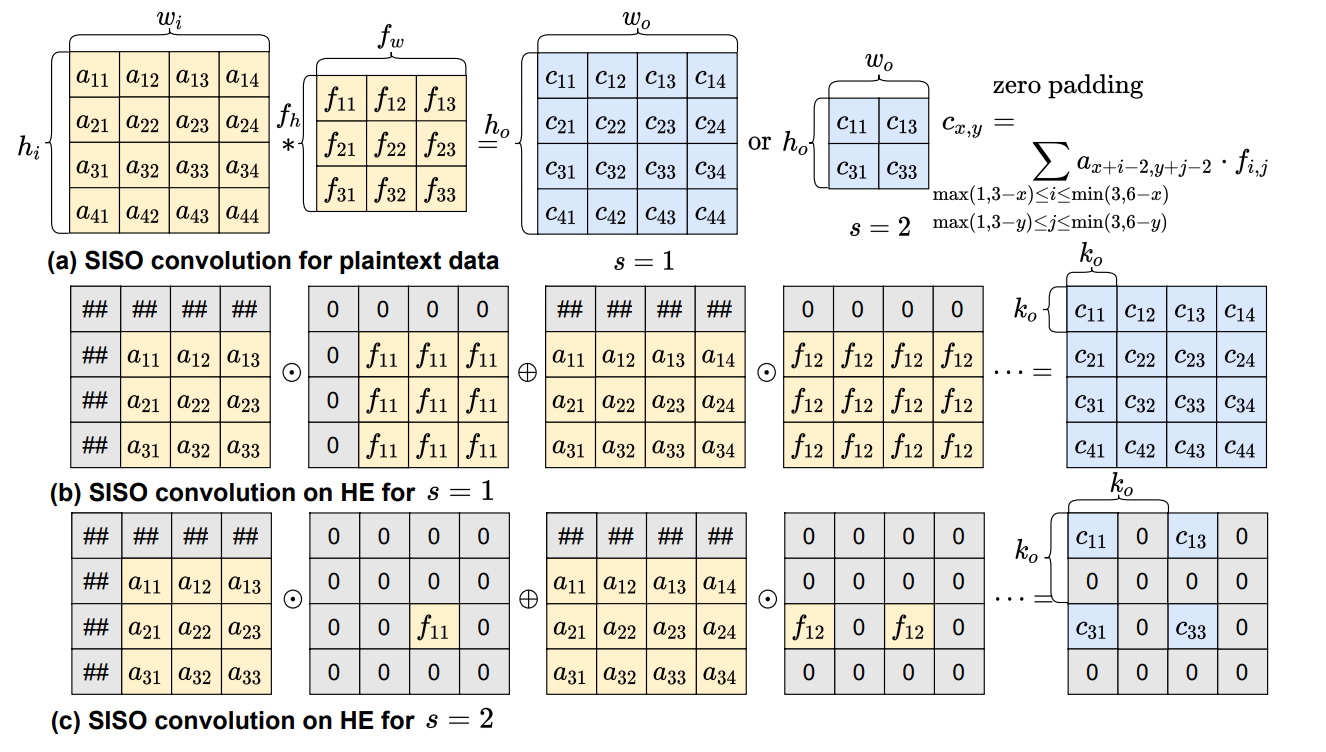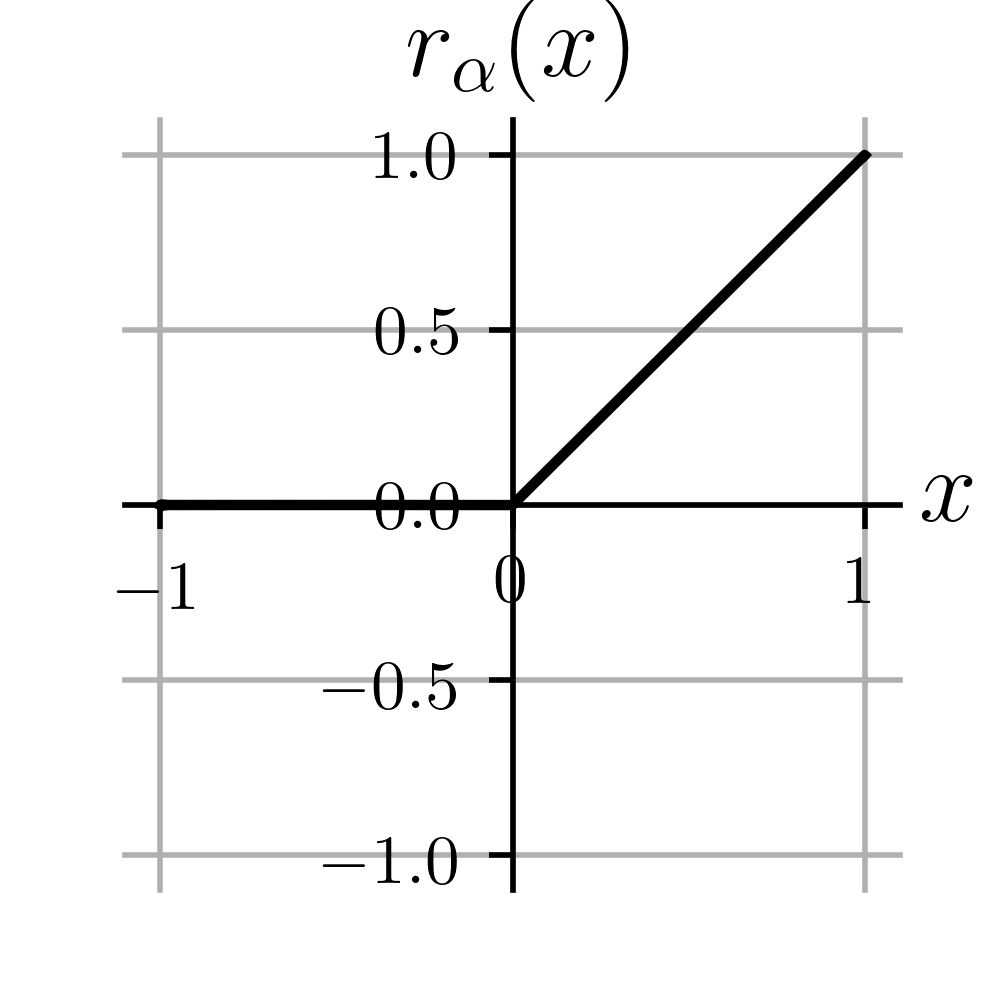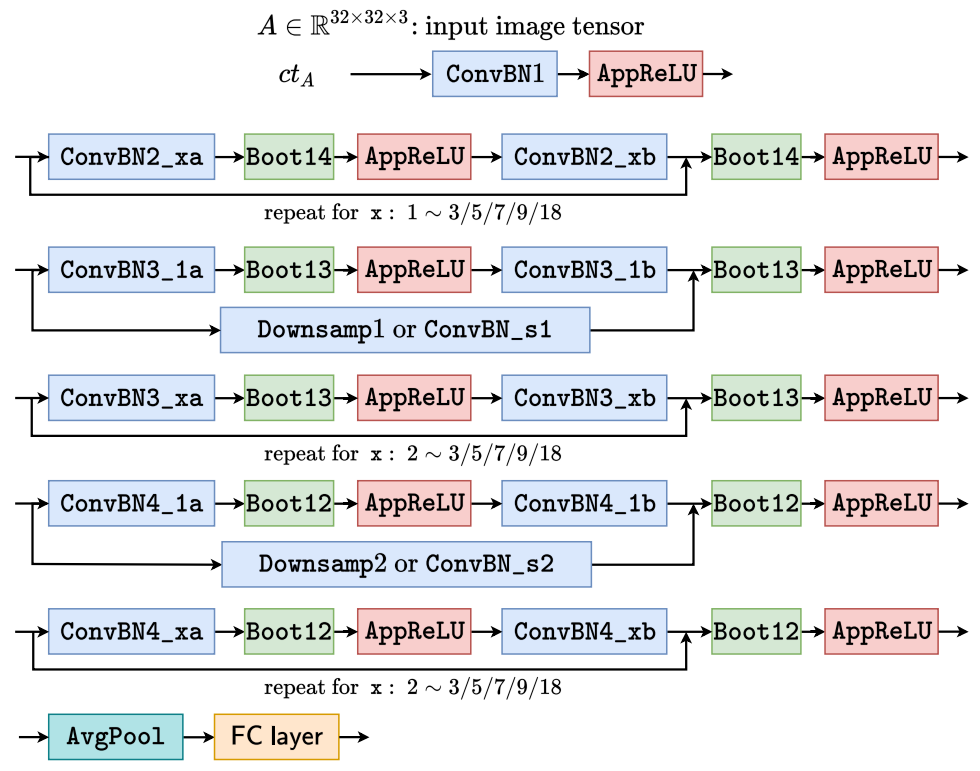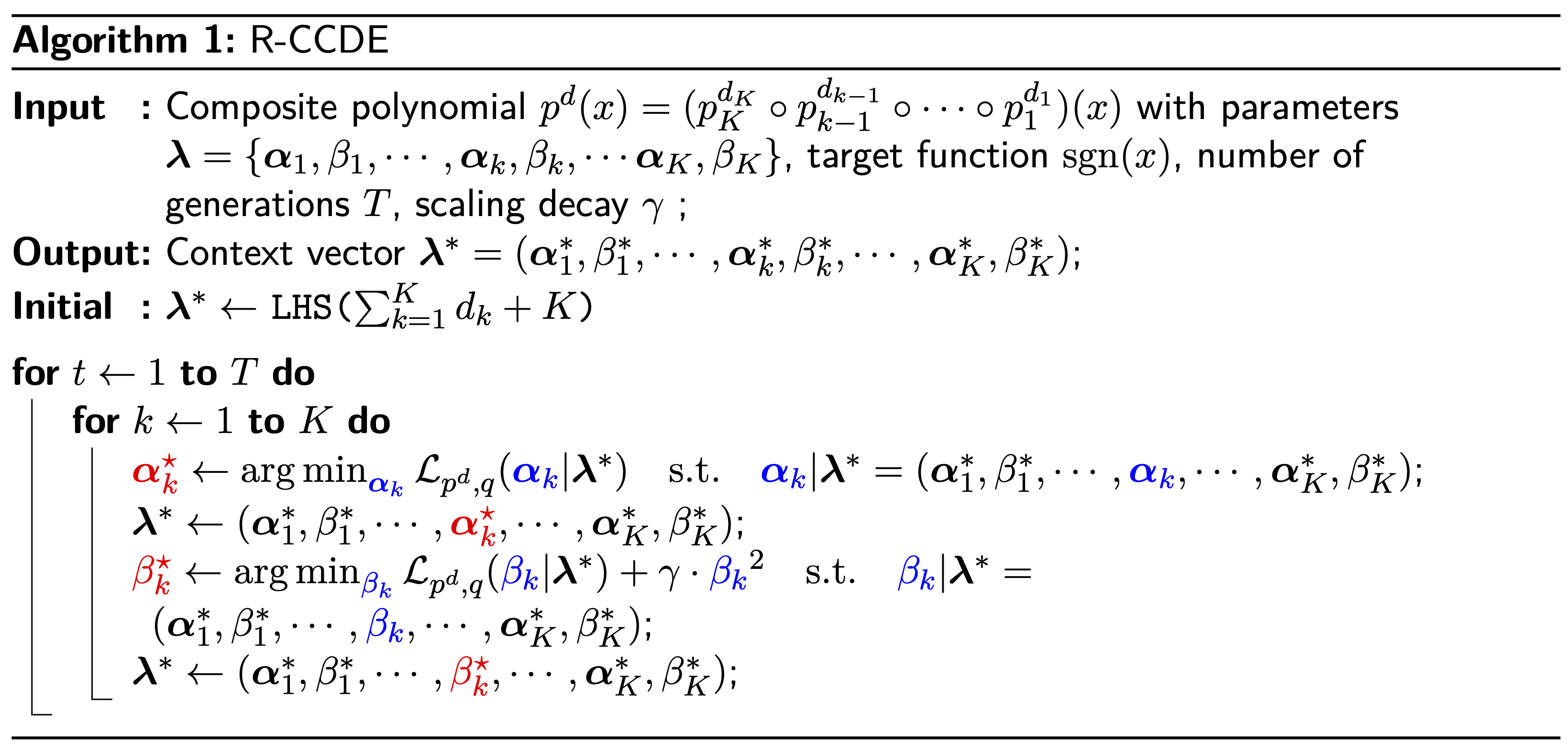Designing CNNs for Secure Inference
CVPR Tutorial
Vishnu Boddeti
June 19, 2023
VishnuBoddeti
Machine Learning as a Service (MLaaS)

Fully Homomorphic Encryption (FHE)
Representation over Cyclotomic Polynomial Rings
- Message $\bm{m}\in \mathbb{C}^{\frac{N}{2}}$ Plaintext $\mu \in \mathcal{R}_{Q_\ell} = \mathbb{Z}_{Q_\ell}[X]/(X^N+1)$ Ciphertext $\bm{c}=(c_0, c_1) \in \mathcal{R}_{Q_\ell}^2$ Level $0\leq l\leq L$, multiplication consumes one level $l-1$. Bootstrapping can refresh $0$-level ciphtertext.
FHE Primitives
- Generate Keys:
- secret key: $s\gets\mathcal{R}_{Q_\ell}$
- public key: $\bm{p}=(-as+e,a)$, $a,e\gets\mathcal{R}_{Q_\ell}$
- Encryption: $\bm{c}=(\mu, 0)+\bm{p}=(\mu-as+e,a)=(c_0,c_1)$
- Decryption: $c_0+c_1s=\mu-as+e+as=\mu+e\approx \mu$
Homomorphic Operations
- Addition: $\bm{c} \oplus \bm{c}^\prime \cong \bm{m} + \bm{m}^\prime$
- Multiplication: $\bm{c}\otimes \bm{c}^\prime \cong \bm{m} \odot \bm{m}^\prime$
- Rotation: $\mathrm{Rot}(\bm{c}, l) \cong \mathrm{Rot}(\bm{m}, l)$
Activation Functions in FHE
Non-linear activation functions, like ReLU, are not supported on FHE.
Polynomial Evaluation under FHE

Complexity of FHE Operations
Primary Bottleneck: Bootstrapping
- Evaluating a deep neural network necessitates bootstrapping
- Bootstrapping dominates latency ($\mathbf{>70\%}$ of execution time)
Convolution under FHE

- Low-Complexity Convolutional Neural Networks on Fully Homomorphic Encryption Using Multiplexed Parallel Convolutions, ICML 2022
Convolution under FHE

Polynomial Approximation of ReLU
- Low-Degree: Levels $\Downarrow$, precision $\Downarrow$

- Faster CryptoNets: Leveraging Sparsity for Real-World Encrypted Inference
- High-Degree: Levels $\Uparrow$, precision $\Uparrow$

- Precise Approximation of Convolutional Neural Networks for Homomorphically Encrypted Data
CNNs under FHE
| Operations | Support |
|---|---|
| Conv2D | ✓ |
| BatchNorm2D | ✓ |
| AvgPool | ✓ |
| Linear | ✓ |
| ReLU | ❌ |
| Bootstrapping | ✓ |
Polynomial Approximation of ReLU
- Level consumption/multiplication Depth = $\log_2\lceil\text{degree}\rceil$
- Degree $\mapsto$ Level consumption $\Uparrow$ $\mapsto$ Bootstrapping $\Uparrow$ $\mapsto$ Latency $\Uparrow\Uparrow\Uparrow$
FHE-MP-CNN: a High-degree Polynomial Solution
- Homomorphic evaluation architecture of ResNets
- Experimental results on CIFAR datasets


- High-degree polynomials $\rightarrow$ Levels $\Uparrow \rightarrow$ Bootstrapping $\Uparrow \rightarrow$ Latency $\Uparrow$
- High-degree polynomials $\rightarrow$ Approximation Precision $\Uparrow \rightarrow$ Accuracy $\Uparrow$
- Low-Complexity Convolutional Neural Networks on Fully Homomorphic Encryption Using Multiplexed Parallel Convolutions, ICML 2022
Multi-Objective Conflict
Conflict between Latency and Accuracy
- Latency
- Low-degree Polynomials $\rightarrow$ Level Consumption $\Downarrow \rightarrow$ Bootstrapping $\Downarrow \rightarrow$ Latency $\Downarrow$
- Accuracy
- High-degree Polynomials $\rightarrow$ Approximation Precision $\Uparrow \rightarrow$ Accuracy $\Uparrow$
Layerwise Polynomials
- Layerwise mixed-degree polynomial networks leverage layerwise approximation sensitivity to accelerate inference while preserving accuracy.
Learn Polynomials and Networks
- Leverage both polynomial approximation of ReLU and learn neural network weights using gradient descent.
Bi-Level Multi-Objective Framework

Framework Overview

Full Search Algorithm
- MOCoEv: Multi-Objective CoEvolutionary algorithm searches for layerwise polynomials
- R-CCDE: Regularized Cooperative Coevolution Differentiable Evolution optimizes coefficients
- PAT: Polynomial-Aware Training can avoid gradient exploding due to polynomials
Flexible Homomorphic Encryption Architecture

Evolving Composite Polynomials
EvoReLU: a composite polynomial
- $\mathrm{EvoReLU}(x)=x\cdot(0.5+p^d(x))$ by using $\mathrm{ReLU}(x)=x\cdot(0.5+0.5\cdot\mathrm{sgn}(x))$
- Composite polynomial $p^d(x)=(p_K^{d_K}\circ\cdots\circ p_2^{d_2}\circ p_1^{d_1})(x)$
- Sub-polynomial $p_k(x)=(1/\beta_k)\sum_{i=1}^{d_k} \alpha_i T_i(x)$, $T_i(x)$ is Chebyshev basis
- Search for number of sub-polynomials $K$, degrees $\{d_k\}_{k=1}^{d_K}$ and coefficients $\{\bm{\alpha}_k, \beta_k\}_{k=1}^K$
Search Variables
| Variable | Options |
|---|---|
| # polynomials $(K)$ | 6 |
| poly degree $()d_k$ | {0,1,3,5,7} |
| coefficients $(\Lambda)$ | $\mathbb{R}$ |

Search Space
Search Space
- High-dimensional multi-objective optimization
- Extremely large search space
| Backbone | # EvoReLU | # Sub-polynomial | Search Space Size |
|---|---|---|---|
| ResNet-20 | 19 | 114 | $10^{79}$ |
| ResNet-32 | 31 | 186 | $10^{130}$ |
| ResNet-44 | 43 | 258 | $10^{180}$ |
| ResNet-56 | 55 | 330 | $10^{230}$ |
Search Objective
Search Objective
$$
\begin{aligned}
\min_{\bm D} & \quad \left\{1-\mathrm{Acc}_{val}\left(f(\bm{\omega}^\ast);\bm{D},\bm{\Lambda}(\bm{D})\right), \mathrm{Boot}(\bm D) \right\} \\
& \quad \bm{\omega}^\ast = \argmin_{\bm{\omega}} \mathcal{L}_{train} \left( f(\bm{\omega});\bm{D},\bm{\Lambda}(\bm{D}) \right)
\end{aligned}
$$
$\bm{D}$ all degrees, $\bm{\Lambda}(\bm{D})$ all coefficients, $\bm{\omega}$ network weight, $ \mathrm{Boot}(\bm D)$ #bootstrapping operations
MOCoEV

Operations
- Selection: Randomly select $N$ solutions from current trade-off front to build a mating set.
- Crossover enables network-level information exchange.
- Mutation is a coevolutionary operation. Explores the $m$-th layer with other layers fixed.
- R-CCDE optimizes polynomial coefficients.
- PAT fine-tunes new solutions $\{\bm{D}_j^\prime, \bm{\Lambda}_j^\prime\}_{j=1}^N$.
- Evaluate accuracy and count bootstrapping.
- Update trade-off front.
R-CCDE Algorithm

R-CCDE: Optimize Polynomial Coefficients

AutoFHE: Bi-Level Multi-Objective Search
Experimental Setup
- Hyperparameters: Generations 20, Population size 50, Coefficient search space $[-5, 5]$, DE population size $10\times\#$variables, Replace sub-polynomial $0.5$, remove sub-polynomial $0.4$, insert sub-polynomial $0.1$
- Time Complexity: On one NVIDIA RTX A6000 GPU, search process for ResNet-20/32/44/56 on CIFAR-10 took 59 hours, 126 hours, 200 hours, 281 hours, respectively. The search for ResNet-32 on CIFAR-100 took 140 hours.
AutoFHE: Better Trade-off

AutoFHE: Better Trade-off under RNS-CKKS FHE
Evaluation under RNS-CKKS FHE
- The inference time for 50 images is evaluated on AMD EPYC 7H12 64-core processor with 50 threads.
- AutoFHE: Automated Adaption of CNNs for Efficient Evaluation over FHE, Cryptology ePrint Archive 2023.
- FHE-MP-CNN: Low-Complexity Convolutional Neural Networks on Fully Homomorphic Encryption Using Multiplexed Parallel Convolutions, ICML 2022
AutoFHE: Layerwise Polynomials

Summary

- Neural networks need to be redesigned for operating on encrypted data.
- Manual design of architecture is difficult, sub-optimal and time-consuming.
- Multi-Objective optimization is an attractive and effective solution in practice.